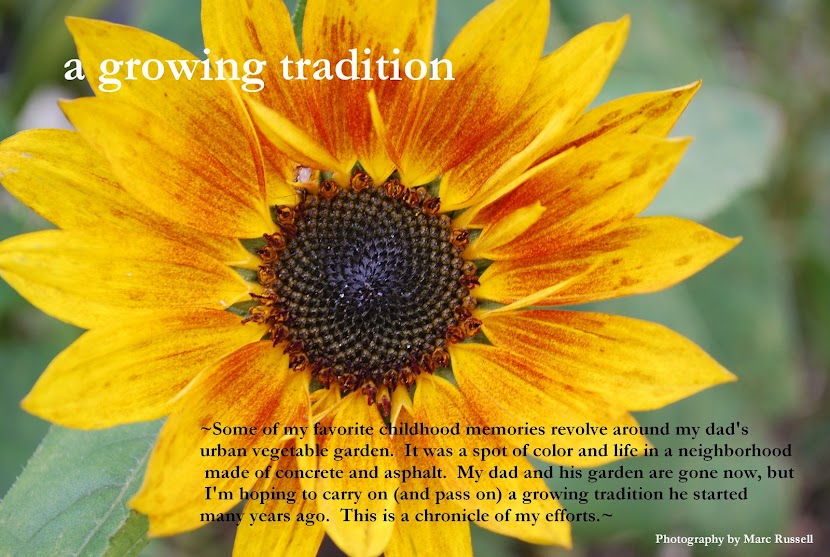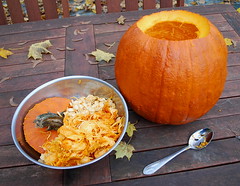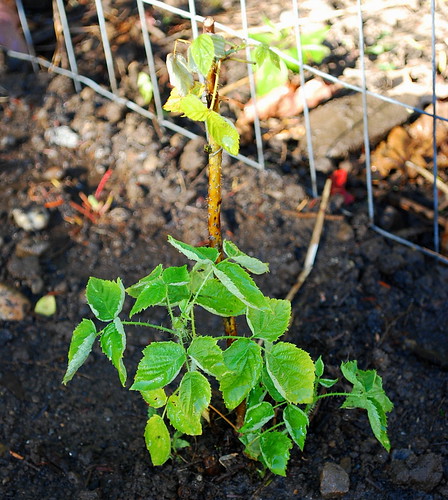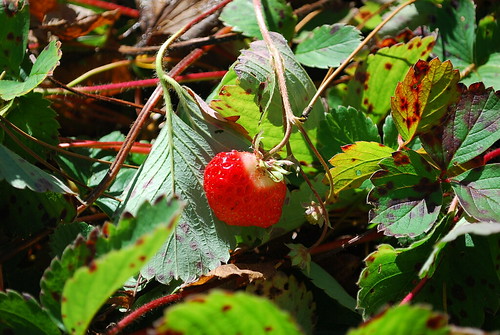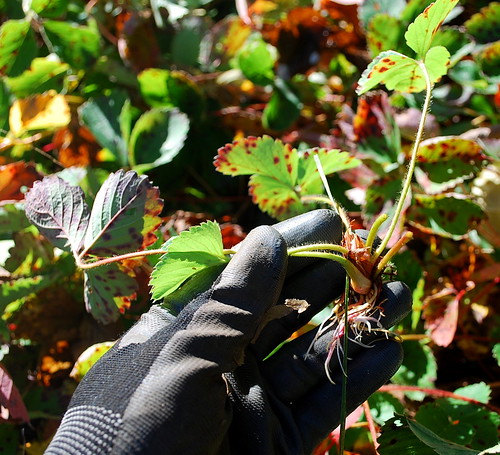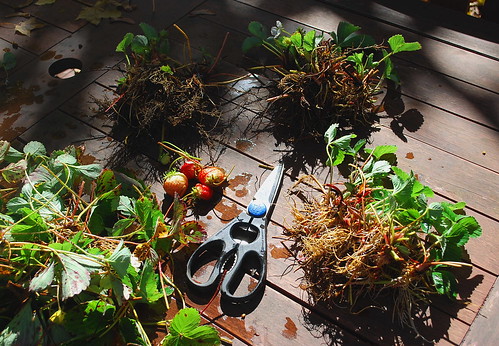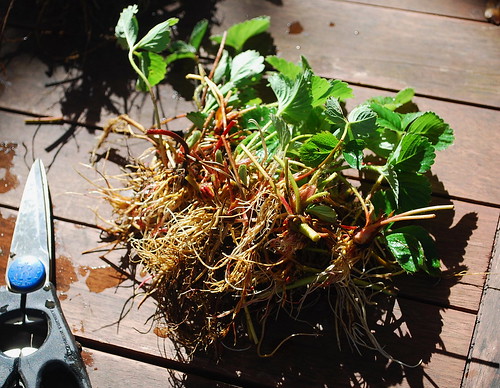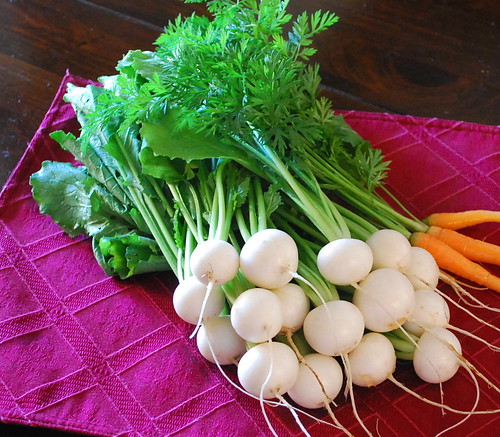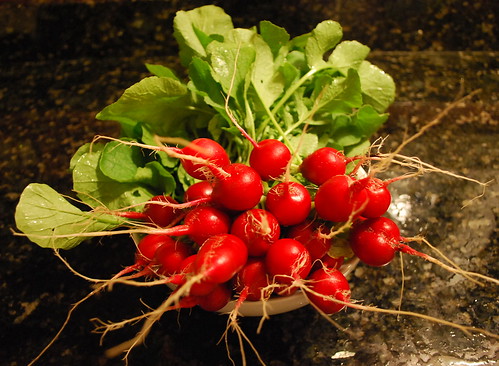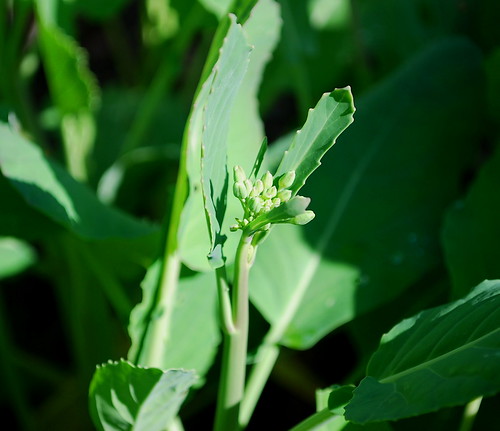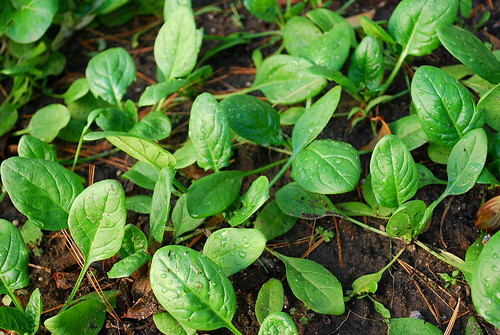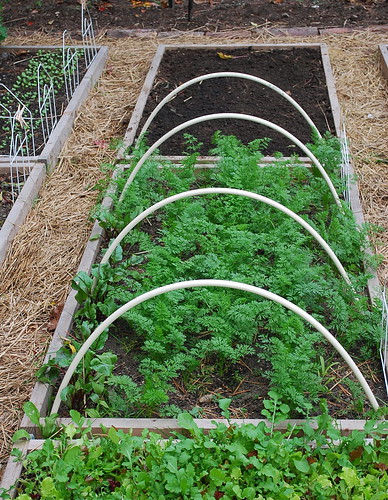
Saturday, October 31, 2009
Friday, October 30, 2009
Venting Hoop Houses
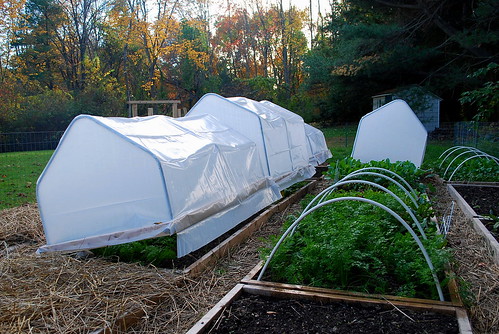
As crazy as it might sound, I've been a bit paranoid lately that I would come home from work to find that all of my fall and winter crops have wilted from the heat of the day...inside my hoop houses that is. Here in New England, we've been enjoying a good dose of Indian summer lately, all the more reason why it's critical to make sure that my hoop houses are properly vented. Last Sunday, while I was doing some work in the garden, I opened one of my hoop houses to find the Spinach looking not so happy, the moist heat hitting me as I lifted the handle. It must have been at least 25 degrees warmer inside. I have to make a mental note to order a couple of max/min thermometers to better monitor how warm it gets inside the hoop houses relative to the temperature outside. I'd like to start keeping a record for future reference. That being said, I hope our Indian summer lasts for a few more weeks.
Thursday, October 29, 2009
A Gift in the Mail - Paying It Forward
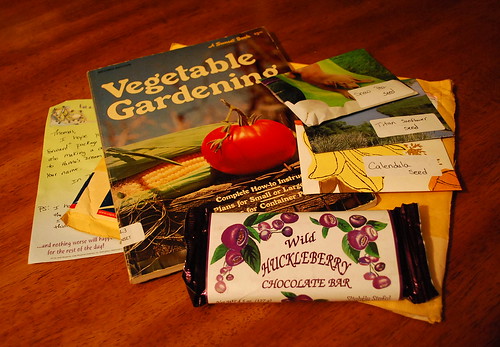
Last week, I received a very thoughtful gift in the mail from Kathie at Two Frog Home. In the package were three handmade seed packs of snow peas, calendula, and Titan sunflower (YES!), a big wild huckleberry chocolate bar (which was enthusiastically devoured) and a classic vegetable gardening book (great gardening methods are timeless). Kathie also made a donation in my name to Hanne's Dream. For those of you who've never visited Kathie's amazing blog, which chronicles her life in Montana, please do!
I accepted this gift with a promise to pay it forward to three other readers of my blog. So, PLEASE email me at agrowingtradition@yahoo.com if you'd like to receive a gift from yours truly and would be willing to pay it forward. If you're one of the first three emails I receive, you'll get a package of goodies ranging from something local, something green and something that benefits the community.
Thanks again, Kathie!
Last Weekend's Other Chores
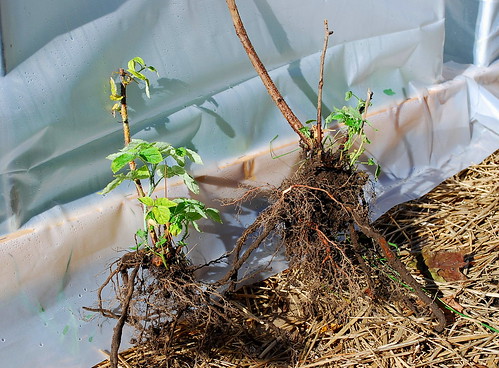
This past weekend, I also transplanted a couple of scraggly looking raspberry plants from the old garden. When we came to visit what was then our future home back in June, I noticed that these plants produced golden raspberries, which were small and a bit moldy at the time.
I gave them a good dose of compost and minerals and planted them next to the strawberries. Hopefully they will like their new location.
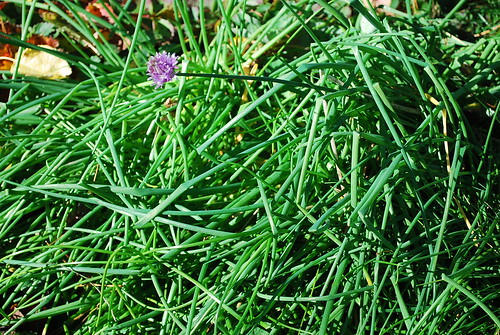
I also found a HUGE clump of chives (or what I think are chives). I had never seen them get this long and scraggly, but I guess this is what happens when you don't harvest them all summer. I dug up about half of it to transplant in the garden.
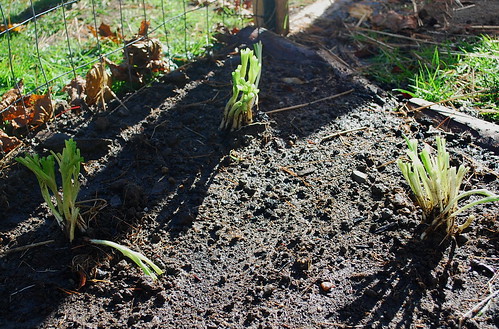
I gave the clump a severe hair cut, divided it into three smaller pieces and planted them next to my garden gate. Hopefully they will have to time to settle in to their new location before the weather gets too cold.
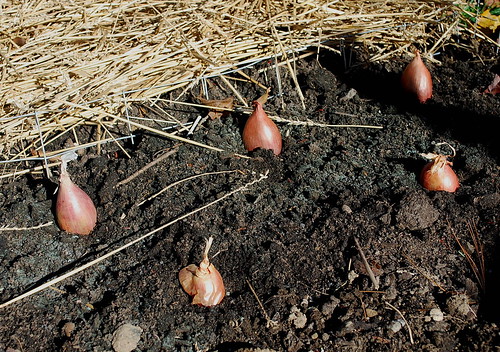
Finally, I am planning on purchasing shallot seeds to sow this spring but decided this past weekend that I would plant a few bulbs right now for fun (and hopefully for an earlier crop). This variety is called "supermarket". HA!
Tuesday, October 27, 2009
Planting a Strawberry Patch
The Old Strawberry Patch
This past Sunday was the perfect fall day - sunny sky, a crisp breeze and stunning colors all around. I couldn't wait to go outside and do some much needed yard work. And as I was putting on my boots, thinking of all things that needed to get done, I realized that it had been a while since I'd made my way down to the prior owner's old garden, which is located toward the far end of our yard. So I took a slight detour from the morning's chores and had a look around. I wasn't surprised to find that the 20 sq ft cluster of mint, which had been cut down to the ground a few months ago, had grown back to half of its initial height of 4 ft. It will undoubtedly take a lot more effort on my part to get rid of this invasive plant.I then made my way over to the right side of garden - home to a rather large and overgrown strawberry patch. As I knelt down for a closer inspection, to my surprise, I found a rouge strawberry. Then another. Parting a few leaves with my hands, I could see that most of runners produced over the years had rooted right through the worn black landscape fabric, which was put down when the garden was first dug. A light bulb then turned on in my head and I decided that what I really needed was new strawberry patch and that I would plant it NOW. The weekend's chores would just have to wait.
I was planning on purchasing new crowns for next year but realized then that I had a huge stock of my own right there in front of me. I gave one of the smaller and newer looking plants a slight pull and to my surprise, the roots came up through the landscape fabric clean and intact. For the next half hour, I would go on a hunting mission for some new runners and 1 year old crowns. It was like finding money.
After I was done, I took my loot back to the house and sorted through my find, cutting off all of the older leaves and separating the crowns into three separate piles - new runners, smaller 1 year old crowns and larger/older crowns.
After the plants were sorted and washed, I chose a large section of my side bed and went to work on amending the soil, adding loads of compost, some blood meal, greensand and rock phosphate. I placed the crowns about 6 inches apart (probably closer than I should have, but I'm expecting that some of them will not make it through the winter). After what felt like a good hour, I had planted over 50 strawberry crowns. I gave them all a long drink of water and covered my new patch with a layer of straw. Now it's just a matter of waiting to see whether or not this idea was just plain crazy.
I'm thinking that I may go on another hunting trip next weekend. I'm my opinion, one can never grow too many strawberries. I'm not sure of this particular variety, but having seen strawberries in June when we first visited the house and the few now, I'm guessing it's an "everbearing" variety that fruits twice a year. If anyone has any advice on how to best plant, overwinter and care for strawberry plants, please share!
Monday, October 26, 2009
Five Fall Crops Worth Mentioning
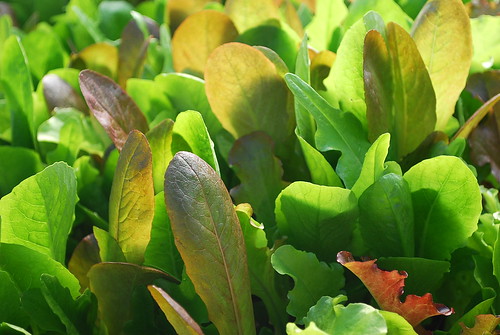
Hello everyone, I just uploaded my third piece for Simple, Green, Frugal Co-op. My post this week highlights five fall vegetables that I grew this year - most of which will sound very familiar to those of you who regularly read this blog. If you have the time or the inclination, you can read about it here.
As always, thanks for the support. I can't tell you how much I've learned from all of you!
"Five Fall Crops Worth Mentioning"- as posted on Simple, Green, Frugal Co-op on September 27, 2009
Posted by Thomas, from A Growing Tradition
When our family moved to our new home in late July, I was a bit disappointed that we had missed out on being able to grow many of the traditional summer crops that seem to dominate seed catalogs these days. While other gardeners were tending to their tomato, cucumber and melon plants, I was breaking ground, raising fence and sowing my fall garden. Looking back, I was glad for the experience. Here in New England, many of us are so focused on getting our summer crops to mature in September (and rightly so) that we often overlook the extended bounty that a traditional fall garden can produce. I experimented with many different types of fall crops this year. And while I've had my fair share of failures along the way, I've learned that all of the planning and effort that goes into growing a proper fall garden is well worth it.
There are many things I look for in a good fall vegetable - quick maturity dates and cold hardiness to name a couple. Instead of listing them all, I thought I'd highlight five crops that I believe exemplify many of these characteristics. In no particular order:
1. The Obvious - Cut and Come Again Lettuce
30 Days to harvest - Fall lettuce/salad mix is the ideal gift that keeps on giving. I can appreciate a crop that will allow me to harvest from it over and over again until a mighty November frost intervenes (longer if you give it some protection). Cooler weather offers two added benefits - 1) you don't have to worry about your lettuce bolting unexpectedly and 2) certain greens (such as arugula) that would normally be too sharp for my taste during the summer months develop a milder flavor. Finally, I consider a fall harvest of salad greens to be the perfect break between the succulent vine-ripened crops of summer and the hardier root vegetables of winter.
2. The Esteemed - Hakurei Turnips
40 days to harvest - I cannot speak highly enough about this vegetable. Those of you who dislike conventional turnips might appreciate this mild and crisp variety from Japan. Prized by top chefs around the world, Hakurei turnips can be enjoyed raw in a salad or lightly cooked. When steamed and tossed with a bit of butter, these turnips taste like the best cauliflower I have ever had (but much easier and faster to grow). Hakurei turnips are best harvested golf ball-sized and produce tasty greens as well. Sow seeds every couple of weeks from mid-August to mid-September to ensure a steady crop throughout most of the fall.
3. The Humble - Radishes
30 days to harvest - I will admit that radishes are not high on my list of favorite things to eat. However, what they lack in taste, they more than make up for in color, which can range anywhere from brilliant to radiant. This humble vegetable grows easily in cool weather and small-type varieties are very quick to mature. Harvest small-type radishes young as they tend to get hot and pithy the larger they get. I enjoy them raw in a salad or pickled.
4. The Tender and Sweet - Chinese Broccoli
45-50 days to harvest - Most Asian greens thrive in cooler weather, and out of these, many are exceptionally cold hardy. The disadvantage of growing Asian greens is that most are susceptible to the same pests that plague other brassicas. Therefore, protection in the form of row covers is generally needed. The advantage is that they usually have relatively short maturity dates. One variety that performed very well for me this year was a flowering-type brassica known as Green Lance, more commonly referred to as Chinese broccoli. The stalk, leaves and flower buds of this plant are all edible. In particular, the stalk (like asparagus) is very tender and sweet. I will continue to grow this vegetable in place of fall broccoli as it is faster to mature, more productive, and in my experience, much less vulnerable to pests.
5. The Nutritional Powerhouse - Spinach
40 days to harvest - There are several varieties of spinach that are exceptionally winter hardy. While other fall greens slowly succumb to frost, spinach will remain surprisingly resilient with a bit of added protection in the form of a cold frame or row covers. The variety that I am growing currently is called "Space". Spinach, like lettuce and most Asian greens, can be harvested during most stages of development, making them a particularly reliable fall crop regardless of how quickly the weather turns cold. And if that is not enough to make you want to grow spinach, its nutritional value should.
I hope you consider growing some of these vegetables in your fall garden. One final peace of advice - please bear in mind that precise sowing dates are much more crucial when planning a fall garden (sow too late and you will end up eating mostly baby greens). You can mitigate this somewhat by utilizing row covers. To be on the safe side, add a couple of weeks to the maturity date listed on the seed packet to help ensure a harvest. If you have any fall crops you particularly love that I have not mentioned here, or have any fall gardening tips that you would like others to know, please share!
Labels:
Asian greens,
Co-op work,
fall crops,
fall gardening,
radishes,
salad greens,
spinach,
turnips
Sunday, October 25, 2009
This Week's Harvest

I started harvesting the all lettuce mix last week. The veggies I have growing under cover have taken off. The added heat and protection of the mini hoop houses have done wonders to speed up growth. The spinach (to the right of the lettuce) seems perfectly happy.
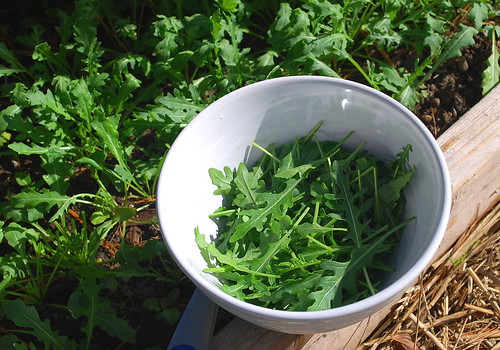
The wild arugula has matured well before the expected maturity date stated on the seed packet. I am very happy with how it has performed. The seed of this particular variety (Sylvetta) is the size of a grain of sugar. It's amazing that all of the ingredients for life can fit inside such a small package.
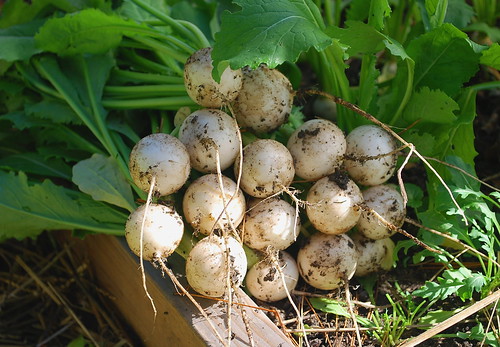
I started harvesting my second sowing of Hakurei turnips this past weekend. This batch is proving to be the best one yet since I was diligent about thinning this time. Most of the ones I pulled were close to their ideal harvest size (golf ball). I have one harvest remaining and will be sad when it is over. I highly recommend this tasty vegetable for the fall and spring garden.
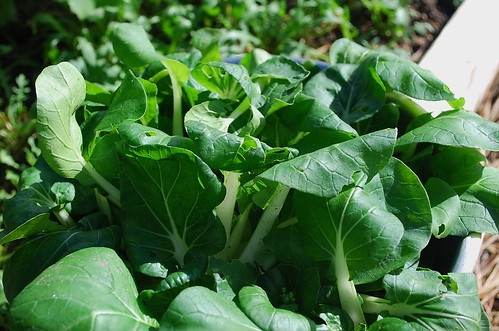
The white stemmed pak choi has seen better days. The cold weather of early October followed by of the Indian summer we've been experiencing this past week have caused the crop to bolt prematurely. These are supposed to grow to several times their current size before doing so. I hope they are still edible.
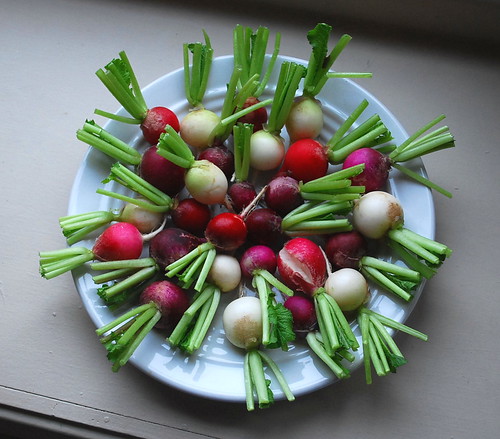
I harvested most of my remaining Easter egg radishes. All of these went to my mother-in-law and next-door neighber. Radishes (though I'm not a huge fan of their taste) are very fun, quick and easy to grow.
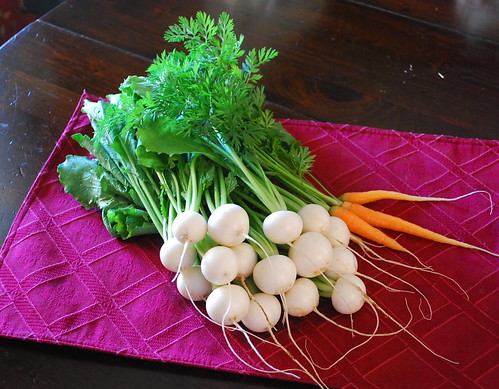
Hakurei turnips have an amazing pearly white color. I also pulled up a few Nantes carrots to see how far along they are. I think they need at least a couple of more weeks in the garden before they will be ready to harvest. My fall carrots are taking MUCH longer to grow then I had expected and as was stated on the seed packet. I'm blaming it on the fact that my garden only gets partial sun. As the leaves from the giant maple in my backyard fall to the ground, my garden is getting more and more light. I wouldn't be surprised if my winter garden gets more hours of direct sunlight than my summer one.
If you'd like to see what other people are harvesting or mention your own, visit Harvest Mondays over at Daphne's Dandelions.
Labels:
Asian greens,
fall crops,
fall harvest,
radishes,
salad greens,
turnips,
weekly harvest
Saturday, October 24, 2009
Currently Reading
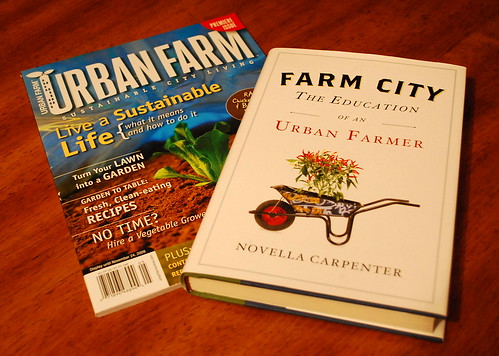
Bookstores are a dangerous place, especially for my wallet. I can never seem to leave one without a book, or at least a magazine, in hand. I picked up a couple of goodies this past week while on my lunch break. First is the premier issue of Urban Farm magazine, brought to us by the folks at Hobby Farm. The creation of this publication is further evidence that the idea of urban farming is becoming more mainstream. Or at least I'd like to think so. I'll read this one from cover to cover before rendering an opinion.
I also purchased a memoir published earlier this year entitled, Farm City- The Education of an Urban Farmer, written by Novella Carpenter. I knew I would like this book the moment I read the first sentence - "I have a farm on a dead-end street in the ghetto." Only 50 pages into it, Carpenter is proving to be a very funny and insightful author. The book is less about the vegetables she grows, and more about the bond she developments with the chickens, ducks, geese, turkeys and pigs she raises for meat. This is made all the more interesting by the fact that Carpenter lives in a distressed duplex apartment and farms on an adjacent abandoned lot in a seemingly lawless section of Oakland, California nicknamed "Ghost town". You can read the first chapter of Farm City and the accompanying New York Times review here.
Friday, October 23, 2009
Thinking About Next Year - Indoor Seed Starting
The other day, I did some "twilight" gardening. Since I don't usually get home from work until about 6 PM, such a thing is becoming unavoidable these days. Thank goodness we have a spotlight in the backyard. I sowed some cloves of softneck garlic purchased from the grocery store (out of curiosity) and several seed mats of Tango lettuce, mache and minutina in one of my mini hoop houses. At this rate, the greens won't be ready until early spring, if at all. Oh well. I like to say that "trial and error" is the best way to learn. The shorter days are also making it impossible for me to take pictures during the week. I guess that will have to be reserved for the weekends along with any major gardening work.
Anyway, now that the fall garden is beginning to wind down (I can't believe it's almost November), I have extra time to think about next spring. One of my projects this winter will be to build shelves and install grow lamps to start seeds indoors. I will admit that I don't know as much as I should about this subject, but I thought I'd share a couple of online resources I came across the other day.
Mother Earth News' Spring Indoor Seed-Starting Guide
University of Minnesota's Article on Starting Seeds Indoors
If anyone knows of other online resources they would like to share, please do!
Anyway, now that the fall garden is beginning to wind down (I can't believe it's almost November), I have extra time to think about next spring. One of my projects this winter will be to build shelves and install grow lamps to start seeds indoors. I will admit that I don't know as much as I should about this subject, but I thought I'd share a couple of online resources I came across the other day.
Mother Earth News' Spring Indoor Seed-Starting Guide
University of Minnesota's Article on Starting Seeds Indoors
If anyone knows of other online resources they would like to share, please do!
Tuesday, October 20, 2009
Planting Garlic
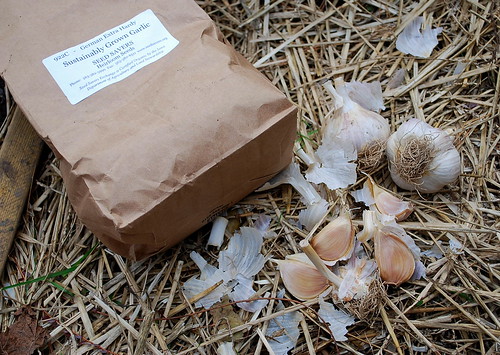
As part of my fall cleanup last week, I was also able to get my garlic in. I planted two hardneck varieties purchased from Seed Savers Exchange - German Extra Hardy and Pskem River. Both are tinged with purple and have lovely plump cloves. I was really tempted to save a clove or two to taste but alas, every last one was destined for the garden.
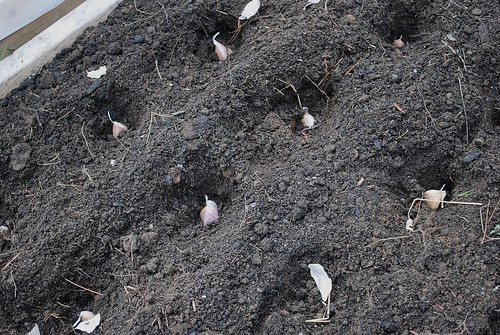
I amended the my beds with greensand, rock phosphate and a good amount of compost, planted each clove 2 inches down (pointy side up) and 8 inches apart, and then covered with 6 inches of straw mulch. That's about it. This is my first time growing garlic so I'm anxious to see how they turn out. I planted about 45 cloves total in two separate beds. I also purchased a couple of softnecks from the supermarket this past weekend and will plant these as well just for fun.

It felt nice to do something for next year's garden...another reminder that winter is just a recess from growing things.
Monday, October 19, 2009
Extending the Season with Quick Hoops
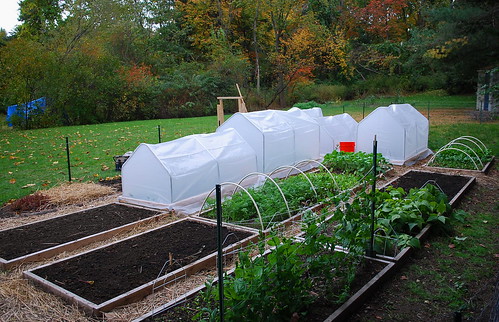
In addition to my mini hoop houses, I also installed some quick hoops during my fall garden cleanup this past week. Now you may be wondering, why would I have both? While hoop houses and quick hoops both extend the growing season, each has it's own advantages and disadvantages. Hoop houses are obviously more expensive to build (or buy) and time consuming to put together, whereas quick hoops are very cheap to purchase and easy to install. However, hoop houses make gardening and harvesting crops a breeze and are more durable under wintry conditions than quick hoops.
Ultimately, the reason why I have both mini hoop houses and quick hoops is because each in my opinion serves a unique purpose in the four season garden. While I will attempt to grow year-round (or as close to year-round as I possibly can) inside my hoop houses, quick hoops are primarily used to give my fall crops the added warmth and protection they need to mature in the event the weather gets unexpectedly cold quickly, which is what happened this past week. After harvesting, the quick hoops will be put away until it's time to get an early start on spring sowings. Quick hoops can also be used to overwinter crops like carrots, in which case, you sow the seeds in November and harvest a super early crop in the spring. Here is a great article about this technique, which was pioneered by farmer/guru Eliot Coleman.
So here is how I set up my quick hoops: I had two raised beds measuring 3 ft by 6 ft each that I needed to cover. I went to Home Depot and purchased 4 quarter-inch PVC conduits measuring 10 ft long. At home, I used a hacksaw to cut each in half, down to 5 ft lengths. I placed 4 hoops over each bed, driving them at least six inches into ground. I was surprised by how sturdy they were, the tension strong enough to keep them perfectly straight. Then I laid 6 mil polyethylene over the hoops and secured it with clothes pins. Finally, I placed a large stone at each corner to keep the poly from blowing away under windy conditions (sand bags can also be used).
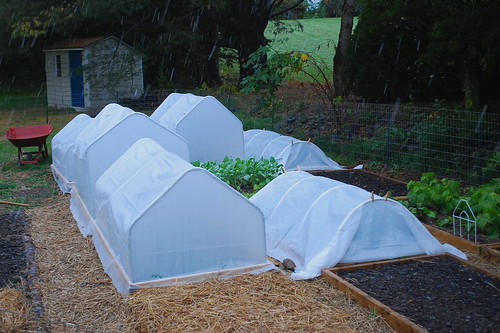
It rained (and snowed) all day Sunday and the quick hoops performed beautifully. Do you utilize quick hoops in YOUR garden?
Sunday, October 18, 2009
This Week's Harvest
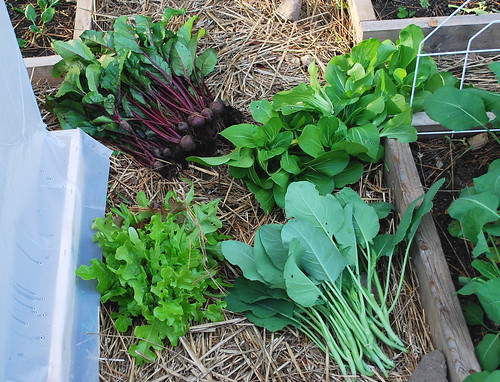
Clockwise from upper left: Red Detroit beets, pak choi, flowering brassica and oak leaf lettuce.

Anticipating more frost and possible snow, I harvested most of my beets last week. Half were medium sized and the rest were baby beets. Despite wishing that they had more time to get bigger, I was really happy with how they tasted.
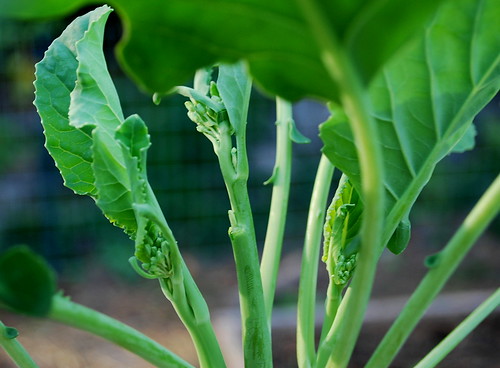
New this week - I picked the first of my flowering brassica. I probably should have waited a little longer but since the weather has been so unpredictable lately, I didn't want to risk losing them to a hard frost. The ideal time to pick them is when the first buds just begin to open. The larger leaves are a bit tough but the main stalk and buds are very sweet and tender...almost like asparagus. I will most likely grow this in place of fall broccoli as it is much less susceptible to pests and faster to mature.

Also new this week - Easter egg radishes. These are tasting crispier and much milder than the red altaglobe radishes I harvested a few weeks ago. I think it is mostly due to the colder weather.
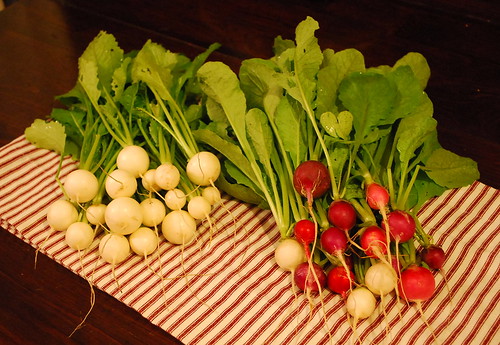
From left: Hakurei turnips and Easter egg radishes.
Finally, as part of my fall cleanup. I harvested the few remaining flowers on my zucchini plants and then pulled them up. These were a bit of a let down this fall but I'm looking forward to starting them again in the spring.
If you'd like to post your own harvest or read about what other people are harvesting, head on over to Daphne's Dandelions.
Labels:
Asian greens,
beets,
fall crops,
fall gardening,
fall harvest,
radishes,
salad greens,
turnips,
weekly harvest,
zucchini
Saturday, October 17, 2009
What's Been Happening Lately
When I first started blogging a few months ago, I found myself thinking, "what could I possibly talk about when the weather gets colder?" And COLDER it has been. Even though the actual "growing" part has slowed way down, I still find myself pulled in many different directions...all of them leading back to the garden. I hope it will stay that way as winter commences. In no particular order, here's what's been happening in my gardening world as of late:
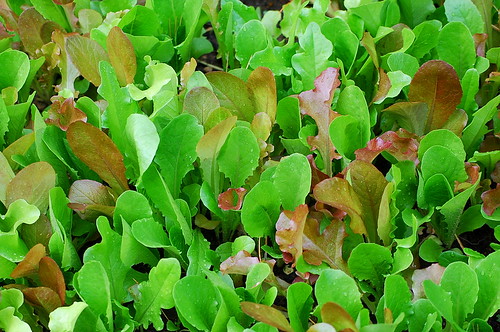
The all lettuce mix that I received from Johnny's is ready to harvest. I haven't had to buy salad greens from the supermarket in the past month and a half. It will be a sad day when I have to again.
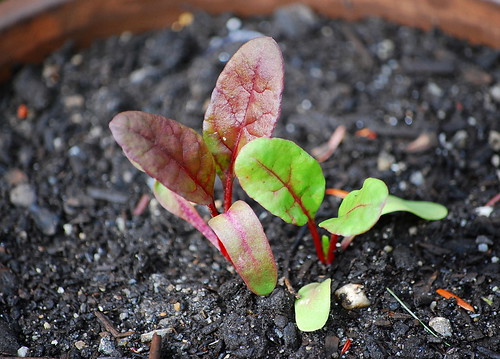
The rainbow chard is still tiny. I have some growing in pots (which I bring in at night) and inside one of my hoop houses. I'm wondering if it's possible to overwinter chard as I doubt I will be eating it any time soon.
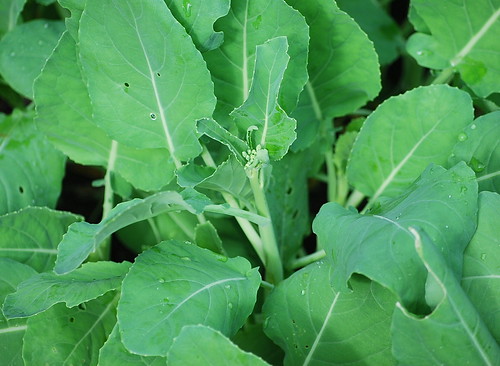
The flowering brassica is starting to bud. I harvested some for dinner earlier this week and it was delicious.
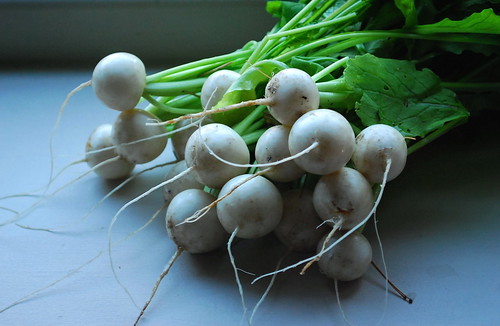
I can't say enough about these Hakurei turnips. Simply steamed and with a little bit of butter added, they taste to me like the best cauliflower I've ever had...but much easier to grow.
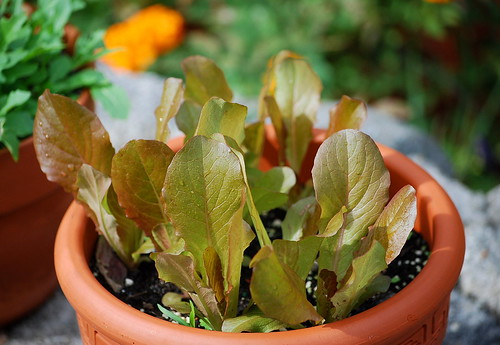
Some red romaine lettuce growing in a pot. I love how it radiates in the sun.

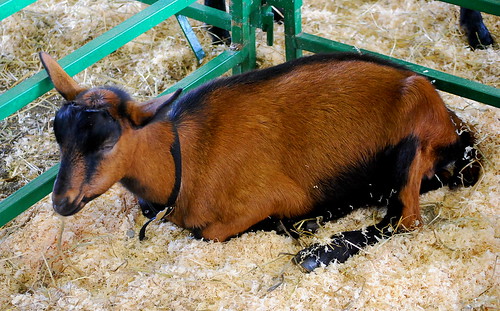
We were able to make it to the Topsfield Fair last weekend. I always look forward to the livestock exhibits. In an ideal world, I would find myself living on a dairy farm on the coast of Prince Edward Island...milking cows and goats and making artisan cheese.
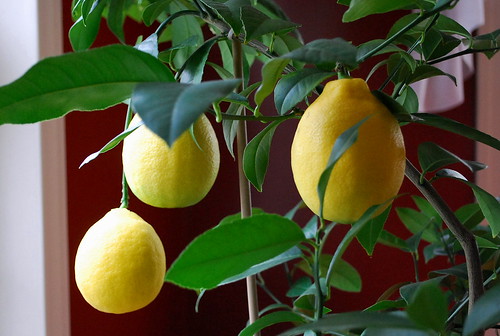
The Meyer lemons are slowly starting to ripen. They won't be ready until their skins turn a deep golden yellow....I'm guessing maybe sometime in November or December.
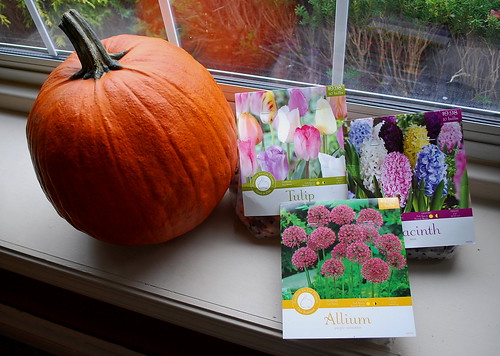
Finally, I'm already looking forward to next spring. To me, there's nothing more comforting than seeing crocus emerge from the frosty ground. As a child, I used to love my dad's tulips. Hopefully these will turn out to be as beautiful as his.

The all lettuce mix that I received from Johnny's is ready to harvest. I haven't had to buy salad greens from the supermarket in the past month and a half. It will be a sad day when I have to again.

The rainbow chard is still tiny. I have some growing in pots (which I bring in at night) and inside one of my hoop houses. I'm wondering if it's possible to overwinter chard as I doubt I will be eating it any time soon.

The flowering brassica is starting to bud. I harvested some for dinner earlier this week and it was delicious.

I can't say enough about these Hakurei turnips. Simply steamed and with a little bit of butter added, they taste to me like the best cauliflower I've ever had...but much easier to grow.

Some red romaine lettuce growing in a pot. I love how it radiates in the sun.


We were able to make it to the Topsfield Fair last weekend. I always look forward to the livestock exhibits. In an ideal world, I would find myself living on a dairy farm on the coast of Prince Edward Island...milking cows and goats and making artisan cheese.

The Meyer lemons are slowly starting to ripen. They won't be ready until their skins turn a deep golden yellow....I'm guessing maybe sometime in November or December.

Finally, I'm already looking forward to next spring. To me, there's nothing more comforting than seeing crocus emerge from the frosty ground. As a child, I used to love my dad's tulips. Hopefully these will turn out to be as beautiful as his.
Labels:
Asian greens,
Citrus,
fall crops,
meyer lemon,
perennial flowers,
salad greens,
turnips
Subscribe to:
Comments (Atom)
